What is digital experience?
Digital experience refers to users’ overall experience when interacting with digital products, services, or platforms. It encompasses all aspects of the user’s interaction, from the user interface (UI) and user experience (UX) design to performance, content, and functionality.

Table of contents
Digital experience is critical for businesses and organizations that rely on digital channels to engage with customers, deliver services, or sell products.
A positive digital experience can lead to customer loyalty and positive word-of-mouth, while a poor digital experience can result in user frustration and negative feedback.
As a result, companies often invest in improving and optimizing their digital experiences to better fulfill the overall customer experience (CX).
Key elements of a digital experience include:
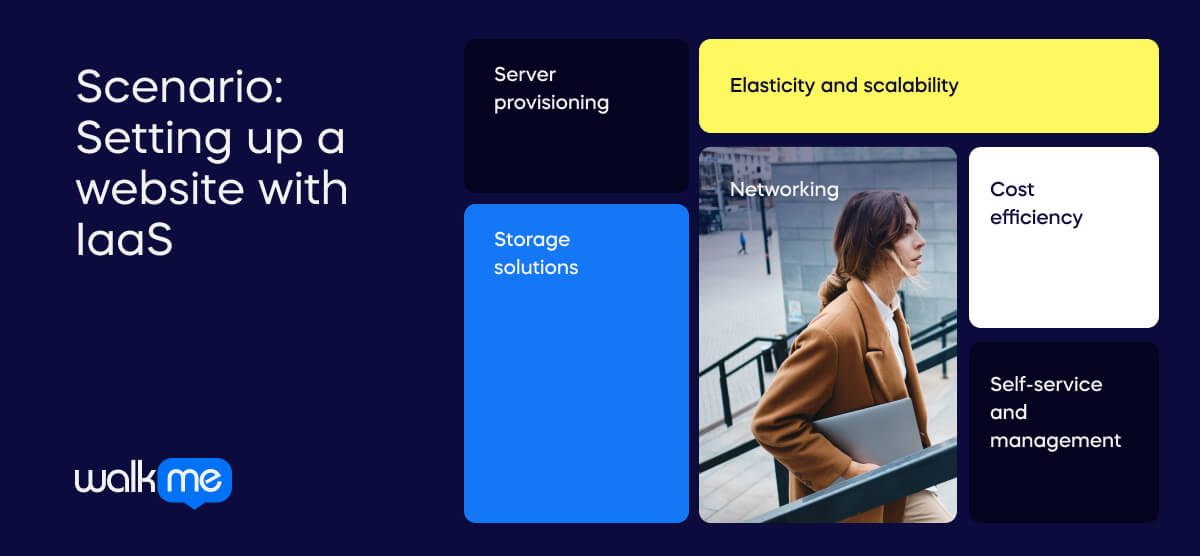
User interface (UI)
This includes the visual design and layout of the digital product, such as web pages, mobile apps, or software interfaces. It focuses on aesthetics, layout, and graphic elements.
User experience (UX)
UX design concerns how easy and enjoyable users can navigate and use the digital product. It involves understanding user behaviors, needs, and pain points to create a seamless and efficient experience.
Performance
A fast and responsive digital experience is essential. Slow-loading pages or unresponsive applications can lead to frustration and may drive users away.
Content
Quality content is crucial. It should be relevant, engaging, and informative. This includes text, images, videos, and other media used in the digital product.
Functionality
The features and functions of the digital product need to work as expected and provide value to users. Bugs or errors can significantly impact the digital experience.
Personalization
Tailoring the experience to individual users or user segments can enhance the digital experience. This can include personalized recommendations, content, or settings.
Accessibility
Digital experiences should be accessible to people with disabilities. This involves ensuring that individuals with different abilities can use the product effectively.
Security
Users need to feel that their data and privacy are protected. Strong security measures are essential for building trust. McKinsey recognizes that, as digital adoption has increased, so have new forms of fraudulent activity.
Therefore, effective fraud management is key to meeting customers’ increasing expectations for digital experiences.
Multi-platform compatibility
In today’s digital landscape, users may access products and services on various devices, from smartphones to desktop computers. Ensuring a consistent experience across platforms is important.
Feedback and support
Providing mechanisms for users to offer feedback or seek support is vital for improving the digital experience and addressing issues.
Benefits of a good digital experience
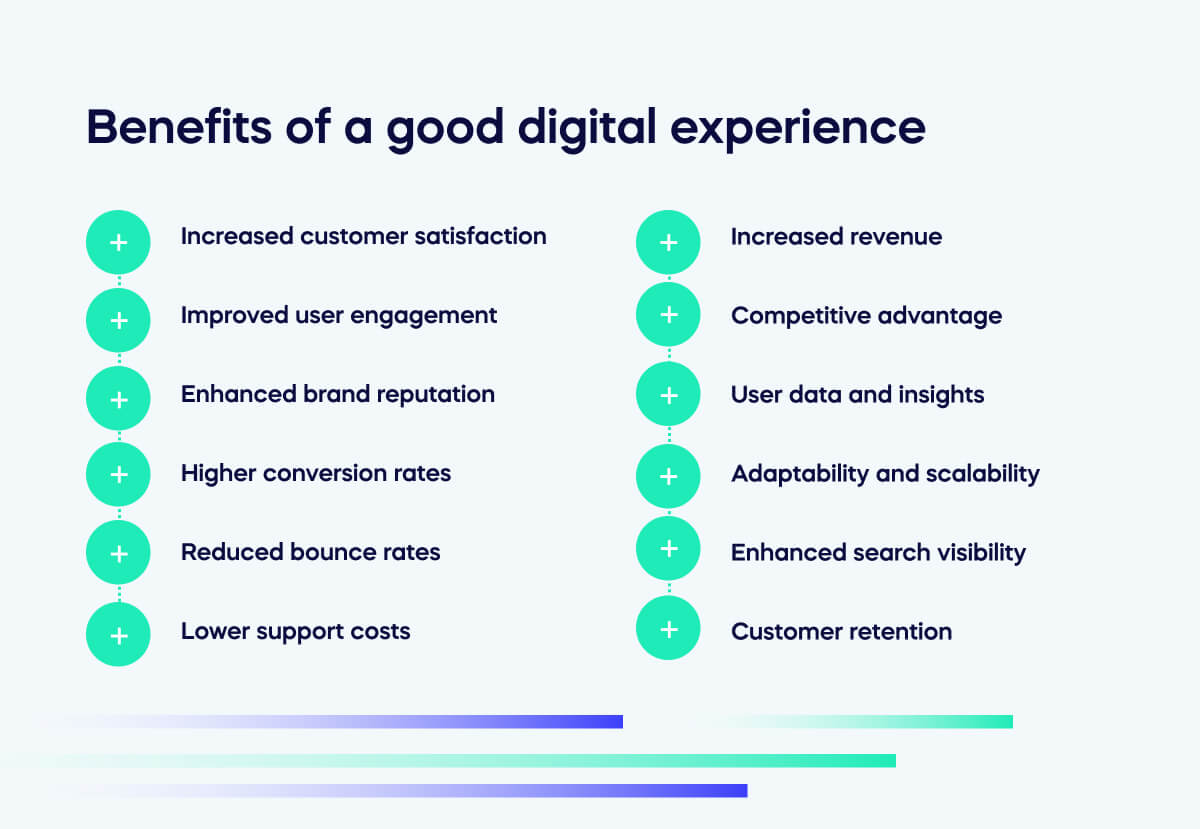
Increased customer satisfaction
Users with a positive digital experience are more likely to be satisfied with your product, service, or platform. This can lead to higher customer retention and loyalty.
Improved user engagement
A seamless and enjoyable digital experience encourages users to spend more time on your platform, increasing customer engagement with your content or services.
Enhanced brand reputation
Good digital experiences build a positive brand image. Users are likelier to recommend your brand to others if they have a satisfying experience, contributing to a strong reputation.
Higher conversion rates
When users have a positive experience, they are more likely to take desired actions, such as purchasing, signing up for a service, or filling out a form, leading to higher conversion rates.
Reduced bounce rates
A well-optimized digital experience helps reduce bounce rates (the percentage of visitors who leave a website after viewing only one page), as users are more likely to explore further.
Lower support costs
With a better digital experience, users encounter fewer issues and require less customer support, reducing operational costs.
Increased revenue
A good digital experience can directly impact revenue by attracting and retaining more customers, increasing sales, and facilitating up-selling or cross-selling opportunities.
Competitive advantage
Offering a superior digital experience can set you apart from competitors, as users are more likely to choose your product or service over others with subpar experiences.
User data and insights
A well-designed digital experience can help you gather valuable user data and insights, which can be used for targeted marketing, product improvements, and data-driven decision-making.
Adaptability and scalability
A positive digital experience can be more easily adapted to changing user needs and scaled to accommodate growth, allowing your digital presence to evolve with your audience.
Enhanced search visibility
Search engines often prioritize websites and platforms that provide a good user experience, leading to higher search rankings and increased organic traffic.
Customer retention
A good digital experience attracts new customers and keeps existing ones coming back, increasing customer retention rates.
Consequences of a bad digital experience
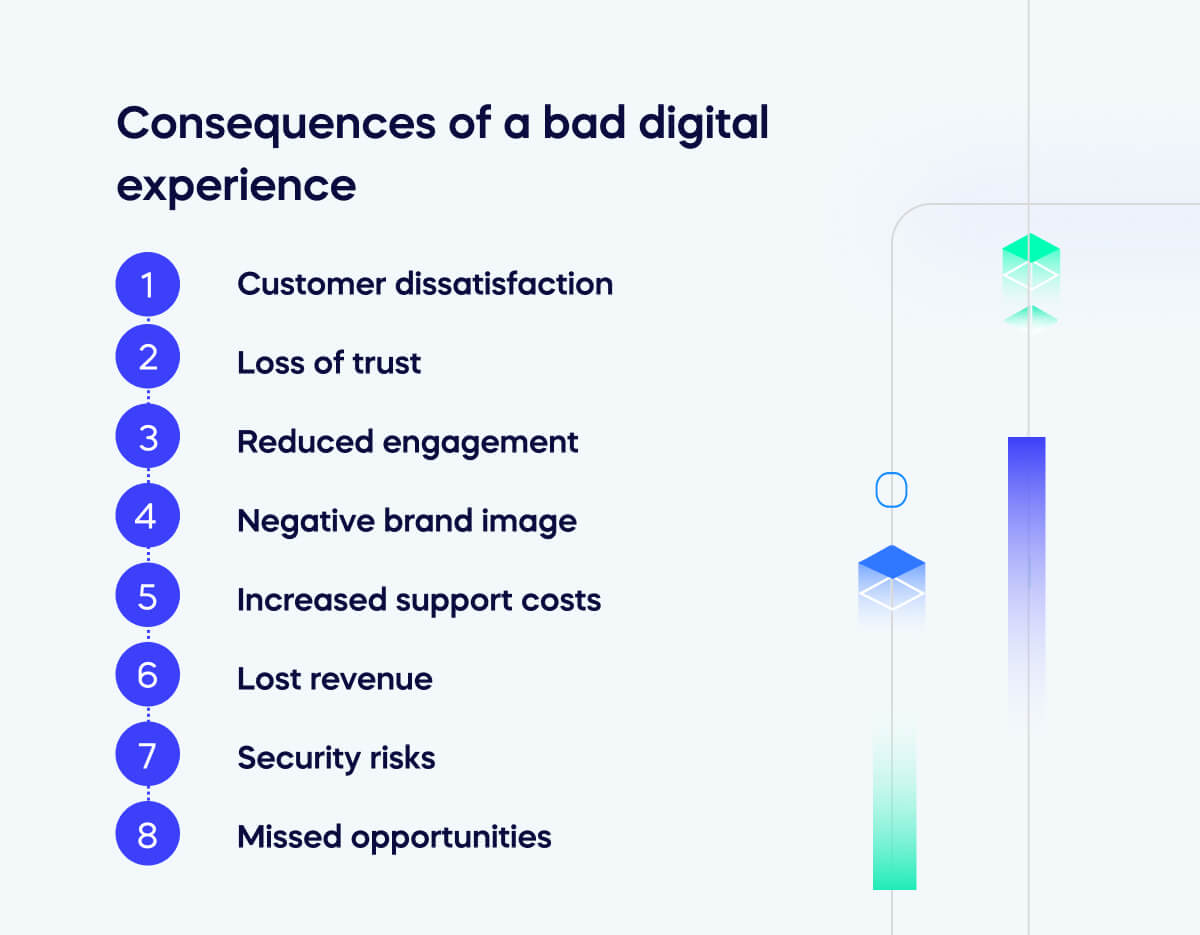
Customer dissatisfaction
For businesses, a poor digital experience can lead to customer dissatisfaction. Users who struggle to navigate a website, app, or online service are less likely to return or recommend it to others. This can result in a loss of customers and revenue.
Loss of trust
Trust is crucial in the digital world. Users may lose confidence in the platform or service if they encounter security breaches, data leaks, or other issues. This can be difficult to regain and may lead to reputational damage.
Reduced engagement
Users are less likely to engage with a digital product or service if they have a bad experience. High bounce rates, low page views, and limited time spent on a website or app can all result from a poor user experience.
Negative brand image
Businesses that consistently provide a poor digital experience can damage their brand image. In the age of online reviews and social media, negative feedback can spread quickly and impact how a company is perceived.
Increased support costs
A bad digital experience can lead to more customer inquiries and support requests. This, in turn, can increase customer support costs and the workload of support teams.
Lost revenue
A clunky or confusing online checkout process can lead to abandoned shopping carts and lost sales. This can directly impact a business’s revenue.
Security risks
A bad digital experience can also result in security risks. Vulnerable or poorly maintained digital systems can be more susceptible to cyberattacks and data breaches.
Missed opportunities
A poor digital experience can cause a business to miss out on valuable opportunities. For example, a confusing website may deter potential partners or investors.
What is a digital experience platform?
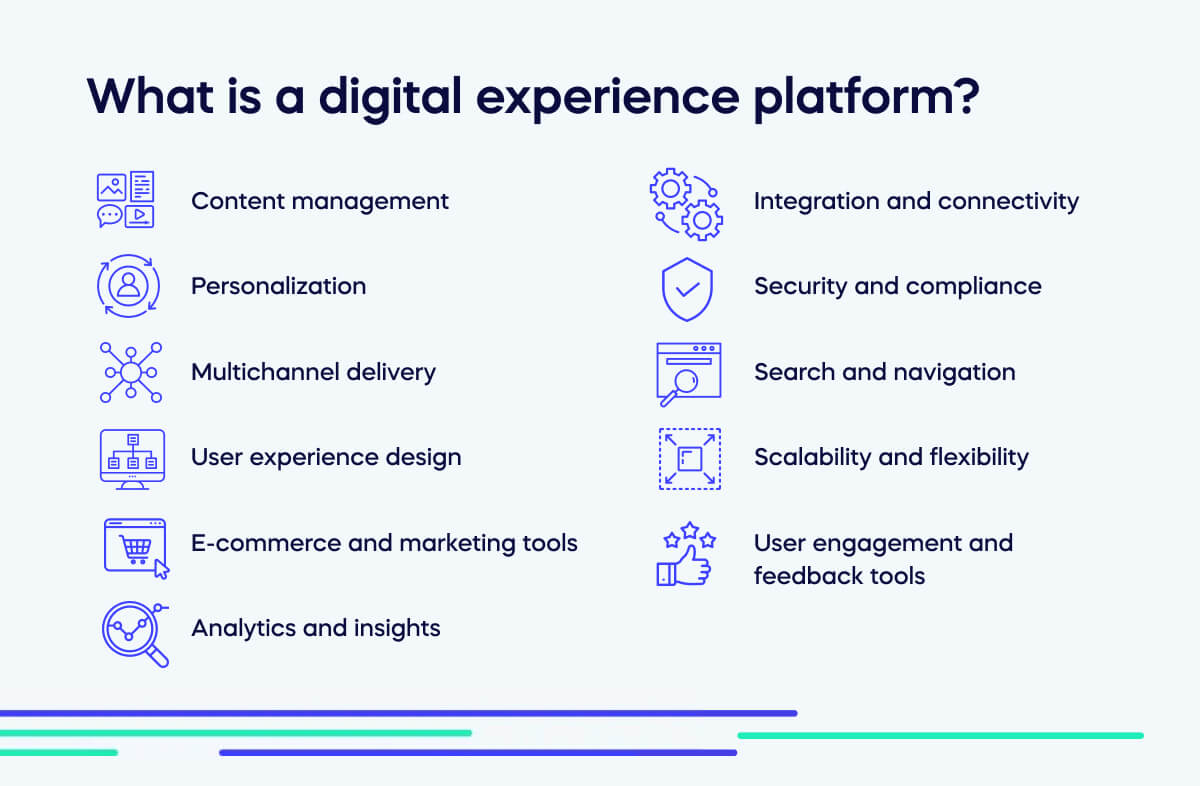
A Digital Experience Platform (DXP) is a comprehensive software solution that enables organizations to manage and deliver consistent, personalized, and engaging digital experiences across various channels and touchpoints.
DXPs are designed to help businesses and other organizations provide a seamless and integrated experience for their customers, employees, partners, and other stakeholders in the digital realm.
Content management
DXPs often include robust content management systems (CMS) that allow organizations to create, edit, and manage digital content such as web pages, articles, images, videos, and more. Content can be optimized for various devices and channels.
Personalization
Personalization is a fundamental aspect of DXPs. They use data and user insights to tailor content and experiences to users’ individual preferences and behaviors. This helps in delivering more relevant and engaging experiences.
Multichannel delivery
DXPs support content delivery across various digital channels, including websites, mobile apps, social media, email, IoT devices, and more. This ensures a consistent experience for users, regardless of their platform.
User experience design
Many DXPs include tools for designing user interfaces, creating user-friendly experiences, and optimizing the user journey. This can involve using templates, drag-and-drop editors, and other design-related features.
E-commerce and marketing tools
DXPs often include e-commerce capabilities and marketing automation tools to help organizations manage and optimize online sales, marketing campaigns, and customer engagement.
Analytics and insights
To gauge the effectiveness of digital experiences, DXPs offer analytics and reporting features. These tools provide data on user behavior, engagement metrics, and other key performance indicators.
Integration and connectivity
Integration capabilities are crucial in DXPs. They allow organizations to connect with various data sources, external systems, and third-party applications, enabling seamless data flow and interaction between systems.
Security and compliance
DXPs prioritize security and compliance with data protection regulations. They often include features like access controls, user authentication, and encryption to ensure the security of digital assets and user data.
Search and navigation
Effective search and navigation features are important for users to find the content they’re looking for quickly and easily. DXPs often include search engines and navigation tools to enhance the user experience.
Scalability and flexibility
DXPs are designed to scale with the needs of an organization. They should be flexible enough to adapt to changing requirements and technological advancements.
User engagement and feedback tools
To improve digital experiences, DXPs may incorporate features for gathering user feedback, conducting surveys, and analyzing user sentiment.
What is digital experience monitoring?
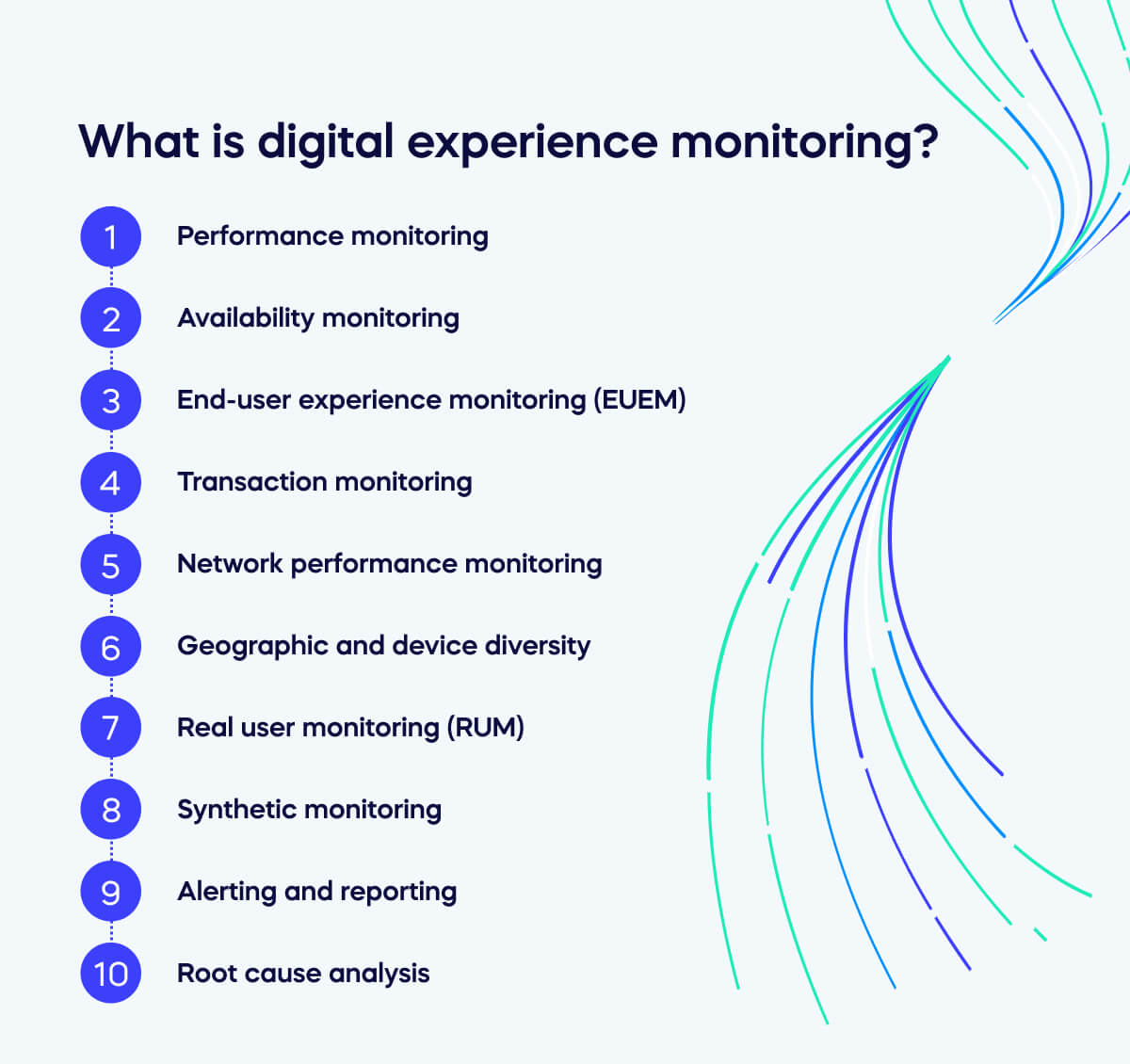
Digital Experience Monitoring (DEM) is a set of practices and technologies that focus on continuously tracking and evaluating the quality of the digital experiences that end-users have when interacting with web applications, websites, mobile apps, and other digital services.
DEM provides organizations with valuable insights into how users perceive and interact with their digital assets and helps identify and address performance issues and areas for improvement. It encompasses various aspects of digital experiences, including performance, availability, and user satisfaction.
Performance monitoring
DEM assesses the performance of digital services, including load times, response times, and the speed at which content is delivered to end-users. This information helps organizations identify bottlenecks and optimize their digital assets for faster loading and smoother interactions.
Availability monitoring
The technology keeps track of the availability and uptime of digital services. It helps detect and respond to outages or disruptions, ensuring users can access the services when needed.
End-user experience monitoring (EUEM)
Businesses can better understand the digital experience from the end-users’ perspective. It captures user interaction data, interface responsiveness, and user satisfaction. This data is valuable for understanding the quality of the user experience.
Transaction monitoring
DEM may include transaction monitoring, simulating and monitoring specific user interactions or transactions on a website or application. This is crucial for e-commerce businesses and other services where user actions (e.g., making a purchase) are vital.
Network performance monitoring
Monitoring the performance and quality of the network infrastructure, such as latency and packet loss, can be an integral part of DEM. Network issues can significantly impact the digital experience.
Geographic and device diversity
DEM considers the diversity of user locations and the devices they use. It helps identify whether users in different regions or using various devices encounter different experiences.
Real user monitoring (RUM)
RUM is a subset of DEM that collects data from actual user interactions, providing real-world insights into the digital experience. RUM data often includes information about page views, click paths, and user behavior.
Gartner research reveals that over 80% of customer service and support leaders cite Voice of the Customer analytics methods as anticipated most-value services in 2023 and beyond.
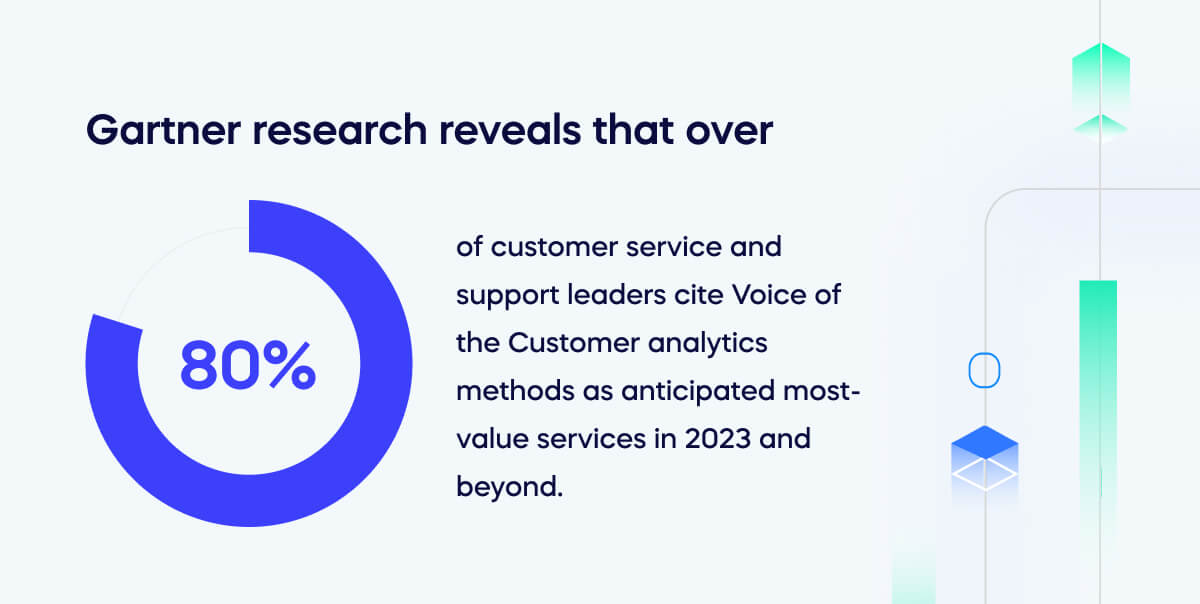
Synthetic monitoring
Synthetic monitoring involves using automated bots or scripts to simulate user interactions and monitor the performance and availability of digital services under controlled conditions. This allows organizations to proactively detect issues before they affect real users.
Alerting and reporting
DEM systems generate alerts and reports based on predefined thresholds or performance indicators. This enables organizations to respond quickly to performance issues and maintain a high-quality digital experience.
Root cause analysis
When performance issues arise, DEM tools often provide diagnostics and insights into the root causes of problems. This information is critical for troubleshooting and resolving issues effectively.
Tools to improve the digital experience
It’s easy to see why customer experience has become a top business priority.
With the rise of technology, customers have come to expect seamless and personalized experiences across all channels. This means that businesses need to constantly improve their digital experience to stay competitive in the market.
One way to do this is by using tools designed to improve the digital experience. These tools can help businesses analyze user behavior, optimize digital channels, and create personalized customer experiences.
Let’s take a look at some of the top tools that businesses can use to enhance their digital experience:
Personalization engines
Personalization engines use data and algorithms to create tailored experiences for individual users. They analyze user behavior, preferences, and historical data to deliver content, products, and recommendations most relevant to each user.
Personalization can significantly enhance user engagement and conversion rates by providing a more customized experience.
Augmented reality (AR) and virtual reality (VR)
AR and VR technologies offer immersive digital experiences. AR overlays digital information in the real world, while VR creates entirely virtual environments. These technologies are used for applications such as gaming, training, virtual tours, and product simulations, providing users with unique and engaging experiences.
Progressive web apps (PWAs)
PWAs are web applications that provide a more app-like experience within web browsers. They are designed to be fast, reliable, and engaging, with features like offline access and push notifications. PWAs bridge the gap between websites and native mobile apps, offering a seamless experience for users.
Chatbots and virtual assistants
Chatbots and virtual assistants are AI-powered tools that interact with users through natural language. They can answer questions, provide recommendations, and offer assistance 24/7. Chatbots and virtual assistants improve user support and engagement by delivering immediate and consistent responses.
User analytics and insights
Analytics tools like Google Analytics, Hotjar, and Mixpanel allow businesses to track user behavior on their websites and apps. They provide valuable insights into user interactions, helping organizations make data-driven decisions to enhance their digital experiences. Insights can include page views, click-through rates, and user demographics.
A/B testing and conversion rate optimization (CRO) tools
A/B testing tools enable organizations to test different variations of web pages or app features to determine which performs better. CRO tools help optimize the user experience by improving conversion rates and achieving specific goals, such as increasing sign-ups or purchases.
Mobile app development platforms
Platforms like React Native and Flutter are used for cross-platform mobile app development. They allow businesses to create mobile apps that work on iOS and Android, ensuring a consistent user experience across different devices and operating systems.
Customer journey mapping tools
These tools help organizations visualize and analyze the entire user journey, from the first interaction to conversion. By mapping the customer journey, businesses can identify pain points and opportunities to improve the overall experience, ensuring a cohesive and user-friendly path.
Content management systems (CMS) with multilingual support
A CMS that supports multiple languages and localization is essential for businesses targeting global audiences. Multilingual support ensures that content is accessible and relevant to users from different regions, improving the user experience for diverse audiences.
Secure and user-friendly authentication methods
Implementing secure identity verification methods such as passwordless authentication, biometrics (e.g., fingerprint or facial recognition), and two-factor authentication (2FA) enhances security while providing a user-friendly and convenient login experience.
Data privacy and compliance tools
GDPR and CCPA compliance tools are essential for businesses to ensure that they handle user data legally and responsibly. Organizations can build trust and provide users with a more secure digital experience by prioritizing data privacy and compliance.
Cross-device synchronization tools
Tools that enable users to seamlessly switch between devices while retaining their session, preferences, and data provide a consistent and uninterrupted digital experience. Users can start an activity on one device and continue it on another without disruption.
Voice search and voice assistant integration
Optimizing digital experiences for voice search and voice commands is becoming increasingly important. Integrating voice search capabilities and voice assistants into websites and applications enhances accessibility and convenience, allowing users to interact using their voices.
Accessibility testing and compliance tools
Accessibility testing tools help ensure digital content is accessible to all users, including those with disabilities. These tools identify and address accessibility issues, such as screen reader compatibility and keyboard navigation, making digital experiences more inclusive and user-friendly.
Cloud-based content delivery networks (CDNs)
CDNs accelerate content delivery by distributing website and app content across servers in various locations. This reduces latency, improves website and app performance, and ensures users can access content quickly and seamlessly, regardless of geographic location.